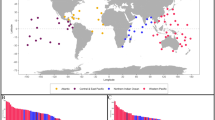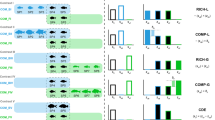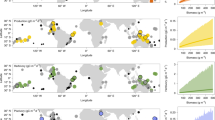Abstract
Habitat associations underpin species ecologies in high-diversity systems. Within tropical, shallow water coral reefs, the relationship between fishes and corals is arguably the most iconic and highly scrutinized. A strong relationship between fishes and reef-building hard corals is often assumed, a belief supported by studies that document the decline of reef fishes following coral loss. However, the extent of this relationship is often unclear, as evidenced by conflicting reports. Here we assess the strength of this ecological association by relying on literature that has surveyed both fishes and corals synchronously. We quantitatively synthesize 723 bivariate correlation coefficients (from 66 papers), published over 38 years, that relate fish metrics (abundance, biomass and species richness) with the percentage of hard coral cover. Remarkably, despite extensive variation, the pattern of association on a global scale reveals a predominantly positive, albeit weak (|r| < 0.4), correlation. Even for commonly hypothesized drivers of fish–coral associations, fish family and trophic group, associations were consistently weak. These findings question our assumptions regarding the strength and ubiquity of fish–coral associations, and caution against assuming a direct and omnipresent relationship between these two iconic animal groups.
This is a preview of subscription content, access via your institution
Access options
Access Nature and 54 other Nature Portfolio journals
Get Nature+, our best-value online-access subscription
$29.99 / 30 days
cancel any time
Subscribe to this journal
Receive 12 digital issues and online access to articles
$119.00 per year
only $9.92 per issue
Buy this article
- Purchase on Springer Link
- Instant access to full article PDF
Prices may be subject to local taxes which are calculated during checkout
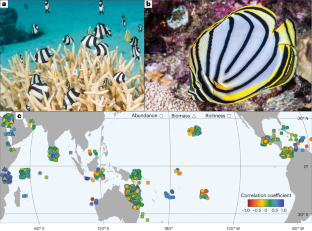

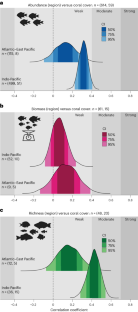
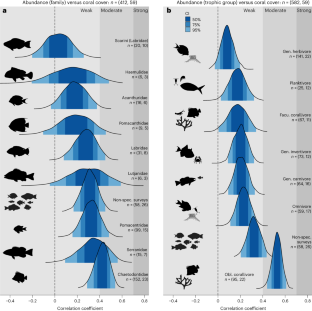
Similar content being viewed by others
Data availability
The datasets generated and/or analysed during our study is available at https://doi.org/10.25903/chbr-5x77.
Code availability
The codes generated during our study is available at https://doi.org/10.25903/chbr-5x77.
References
Morrison, M. L., Marcot, B. & Mannan, W. Wildlife–Habitat Relationships: Concepts and Applications (Island Press, 2012).
MacArthur, R. H. & MacArthur, J. W. On bird species diversity. Ecology 42, 594–598 (1961).
Soto-Shoender, J. R., McCleery, R. A., Monadjem, A. & Gwinn, D. C. The importance of grass cover for mammalian diversity and habitat associations in a bush encroached savanna. Biol. Conserv. 221, 127–136 (2018).
Connell, J. H. Diversity in tropical rain forests and coral reefs. Science 199, 1302–1310 (1978).
Bellwood, D. R. & Hughes, T. P. Regional-scale assembly rules and biodiversity of coral reefs. Science 292, 1532–1534 (2001).
Komyakova, V., Munday, P. L. & Jones, G. P. Relative importance of coral cover, habitat complexity and diversity in determining the structure of reef fish communities. PLoS ONE 8, e83178 (2013).
Stoddart, D. R. Ecology and morphology of recent coral reefs. Biol. Rev. 44, 433–498 (1969).
Cheal, A. J. et al. Responses of coral and fish assemblages to a severe but short-lived tropical cyclone on the Great Barrier Reef, Australia. Coral Reefs 21, 131–142 (2002).
Hughes, T. P. Catastrophes, phase shifts, and large-scale degradation of a Caribbean coral reef. Science 265, 1547–1551 (1994).
Jones, G. P. & Syms, G. Disturbance, habitat structure and the ecology of fishes on coral reefs. Aust. J. Ecol. 23, 287–297 (1998).
Coker, D. J., Wilson, S. K. & Pratchett, M. S. Importance of live coral habitat for reef fishes. Rev. Fish Biol. Fish. 24, 89–126 (2014).
Cole, A. J., Pratchett, M. S. & Jones, G. P. Diversity and functional importance of coral-feeding fishes on tropical coral reefs. Fish Fish. 9, 286–307 (2008).
Russ, G. R., Rizzari, J. R., Abesamis, R. A. & Alcala, A. C. Coral cover a stronger driver of reef fish trophic biomass than fishing. Ecol. Appl. 31, e02224 (2021).
Bell, J. & Galzin, R. Influence of live coral cover on coral-reef fish communities. Mar. Ecol. Prog. Ser. 15, 265–274 (1984).
Booth, D. J. & Beretta, G. A. Changes in a fish assemblage after a coral bleaching event. Mar. Ecol. Prog. Ser. 245, 205–212 (2002).
Jones, G. P., McCormick, M. I., Srinivasan, M. & Eagle, J. V. Coral decline threatens fish biodiversity in marine reserves. Proc. Natl Acad. Sci. USA 101, 8251–8253 (2004).
Wilson, S. K., Graham, N. A. J., Pratchett, M. S., Jones, G. P. & Polunin, N. V. C. Multiple disturbances and the global degradation of coral reefs: are reef fishes at risk or resilient? Global Change Biol. 12, 2220–2234 (2006).
Pratchett, M. S., Hoey, A. S., Wilson, S. K., Messmer, V. & Graham, N. A. J. Changes in biodiversity and functioning of reef fish assemblages following coral bleaching and coral loss. Diversity 3, 424–452 (2011).
Ceccarelli, D. M., Emslie, M. J. & Richards, Z. T. Post-disturbance stability of fish assemblages measured at coarse taxonomic resolution masks change at finer scales. PLoS ONE 11, e0156232 (2016).
Yan, H. F. & Bellwood, D. R. Multi-decadal stability of fish productivity despite increasing coral reef degradation. Funct. Ecol. 37, 1245–1255 (2023).
Friedlander, A. M. & Parrish, J. D. Habitat characteristics affecting fish assemblages on a Hawaiian coral reef. J. Exp. Mar. Biol. Ecol. 224, 1–30 (1998).
Wismer, S., Tebbett, S. B., Streit, R. P. & Bellwood, D. R. Spatial mismatch in fish and coral loss following 2016 mass coral bleaching. Sci. Total Environ. 650, 1487–1498 (2019).
Wismer, S., Tebbett, S. B., Streit, R. P. & Bellwood, D. R. Young fishes persist despite coral loss on the Great Barrier Reef. Commun. Biol. 2, 1–7, 456 (2019).
Wilson, S. K. et al. Habitat utilization by coral reef fish: implications for specialists vs. generalists in a changing environment. J. Anim. Ecol. 77, 220–228 (2008).
Siqueira, A. C., Muruga, P. & Bellwood, D. R. On the evolution of fish–coral interactions. Ecol. Lett. 26, 1348–1358 (2023).
Pratchett, M. S. et al. in Oceanography and Marine Biology Vol. 46, 251–296 (CRC Press, 2008).
Munday, P. L., Jones, G. P., Pratchett, M. S. & Williams, A. J. Climate change and the future for coral reef fishes. Fish Fish. 9, 261–285 (2008).
Strona, G. et al. Global tropical reef fish richness could decline by around half if corals are lost. Proc. Biol. Sci. 288, 20210274 (2021).
Gurevitch, J., Koricheva, J., Nakagawa, S. & Stewart, G. Meta-analysis and the science of research synthesis. Nature 555, 175–182 (2018).
Borenstein, M., Hedges, L. V, Higgins, J. P. T. & Rothstein, H. R. Introduction to Meta-analysis (John Wiley & Sons, 2009).
Nakagawa, S. & Cuthill, I. C. Effect size, confidence interval and statistical significance: a practical guide for biologists. Biol. Rev. Camb. Philos. Soc. 82, 591–605 (2007).
Schober, P. & Schwarte, L. A. Correlation coefficients: appropriate use and interpretation. Anesth. Analg. 126, 1763–1768 (2018).
Bejarano, I. & Appeldoorn, R. S. Seawater turbidity and fish communities on coral reefs of Puerto Rico. Mar. Ecol. Prog. Ser. 474, 217–226 (2013).
Benfield, S., Baxter, L., Guzman, H. M. & Mair, J. M. A comparison of coral reef and coral community fish assemblages in Pacific Panama and environmental factors governing their structure. J. Mar. Biol. Assoc. U. K. 88, 1331–1341 (2008).
Boaden, A. E. & Kingsford, M. J. Predators drive community structure in coral reef fish assemblages. Ecosphere 6, 1–33 (2015).
Bouchon-Navaro, Y. & Bouchon, C. Correlations between chaetodontid fishes and coral communities of the Gulf of Aqaba (Red Sea). Environ. Biol. Fishes 25, 47–60 (1989).
Brewer, T. D., Cinner, J. E., Green, A. & Pandolfi, J. M. Thresholds and multiple scale interaction of environment, resource use, and market proximity on reef fishery resources in the Solomon Islands. Biol. Conserv. 142, 1797–1807 (2009).
Burt, J. A. et al. Biogeographic patterns of reef fish community structure in the northeastern Arabian Peninsula. ICES J. Mar. Sci. 68, 1875–1883 (2011).
Campbell, S. J. et al. Avoiding conflicts and protecting coral reefs: customary management benefits marine habitats and fish biomass. Oryx 46, 486–494 (2012).
Chung, F. C., Komilus, C. F. & Mustafa, S. Effect of the creation of a marine protected area on populations of Coral Trout in the coral triangle region. Reg. Stud. Mar. Sci. 10, 1–9 (2017).
Cox, C., Valdivia, A., McField, M., Castillo, K. & Bruno, J. F. Establishment of marine protected areas alone does not restore coral reef communities in Belize. Mar. Ecol. Prog. Ser. 563, 65–79 (2017).
Crosby, M. P. & Reese, E. S. Relationship of habitat stability and intra-specific population dynamics of an obligate corallivore butterflyfish. Aquat. Conserv. Mar. Freshw. Ecosyst. 15, 13–25 (2005).
Dominici-Arosemena, A. & Wolff, M. Reef fish community structure in the Tropical Eastern Pacific (Panamá): living on a relatively stable rocky reef environment. Helgol. Mar. Res. 60, 287–305 (2006).
Emslie, M. J., Pratchett, M. S., Cheal, A. J. & Osborne, K. Great Barrier Reef butterflyfish community structure: the role of shelf position and benthic community type. Coral Reefs 29, 705–715 (2010).
Emslie, M. J. et al. Regional-scale variation in the distribution and abundance of farming damselfishes on Australia’s Great Barrier Reef. Mar. Biol. 159, 1293–1304 (2012).
Epstein, H. E. & Kingsford, M. J. Are soft coral habitats unfavourable? A closer look at the association between reef fishes and their habitat. Environ. Biol. Fishes 102, 479–497 (2019).
Espinosa-Andrade, N., Suchley, A., Reyes-Bonilla, H. & Alvarez-Filip, L. The no-take zone network of the Mexican Caribbean: assessing design and management for the protection of coral reef fish communities. Biodivers. Conserv. 29, 2069–2087 (2020).
Feary, D. A. et al. Fish communities on the world’s warmest reefs: what can they tell us about the effects of climate change in the future? J. Fish Biol. 77, 1931–1947 (2010).
Feeney, W. E. et al. Long term relationship between farming damselfish, predators, competitors and benthic habitat on coral reefs of Moorea Island. Sci. Rep. 11, 1–8, 14548 (2021).
Galbraith, G. F., Cresswell, B. J., McCormick, M. I., Bridge, T. C. & Jones, G. P. High diversity, abundance and distinct fish assemblages on submerged coral reef pinnacles compared to shallow emergent reefs. Coral Reefs 40, 335–354 (2021).
Garpe, K. C. & Öhman, M. C. Non-random habitat use by coral reef fish recruits in Mafia Island Marine Park, Tanzania. Afr. J. Mar. Sci. 29, 187–199 (2007).
Garpe, K. C. & Öhman, M. C. Coral and fish distribution patterns in Mafia Island Marine Park, Tanzania: fish–habitat interactions. Hydrobiologia 498, 191–211 (2003).
Glynn, P. W., Enochs, I. C., Afflerbach, J. A., Brandtneris, V. W. & Serafy, J. E. Eastern Pacific reef fish responses to coral recovery following El Niño disturbances. Mar. Ecol. Prog. Ser. 495, 233–247 (2014).
Graham, N. A. J., Wilson, S. K., Pratchett, M. S., Polunin, N. V. C. & Spalding, M. D. Coral mortality versus structural collapse as drivers of corallivorous butterflyfish decline. Biodivers. Conserv. 18, 3325–3336 (2009).
Harborne, A. R. et al. Direct and indirect effects of nursery habitats on coral-reef fish assemblages, grazing pressure and benthic dynamics. Oikos 125, 957–967 (2016).
Hempson, T. N. et al. Coral reef mesopredators switch prey, shortening food chains, in response to habitat degradation. Ecol. Evol. 7, 2626–2635 (2017).
Hoey, A. S., Pratchett, M. S. & Cvitanovic, C. High macroalgal cover and low coral recruitment undermines the potential resilience of the world’s southernmost coral reef assemblages. PLoS ONE 6, e25824 (2011).
Howard, K. G., Schumacher, B. D. & Parrish, J. D. Community structure and habitat associations of parrotfishes on Oahu, Hawaii. Environ. Biol. Fishes 85, 175–186 (2009).
Johansson, C. L., Bellwood, D. R. & Depczynski, M. The importance of live coral for small-sized herbivorous reef fishes in physically challenging environments. Mar. Freshw. Res. 63, 672–679 (2012).
Khalaf, M. A. & Abdallah, M. Spatial distribution of fifty ornamental fish species on coral reefs in the Red Sea and Gulf of Aden. Zookeys 367, 33–64 (2014).
Khalaf, M. A. & Kochzius, M. Community structure and biogeography of shore fishes in the Gulf of Aqaba, Red Sea. Helgol. Mar. Res. 55, 252–284 (2002).
Kingsford, M. J. Contrasting patterns of reef utilization and recruitment of coral trout (Plectropomus leopardus) and snapper (Lutjanus carponotatus) at One Tree Island, southern Great Barrier Reef. Coral Reefs 28, 251–264 (2009).
Lamy, T., Galzin, R., Kulbicki, M., Lison de Loma, T. & Claudet, J. Three decades of recurrent declines and recoveries in corals belie ongoing change in fish assemblages. Coral Reefs 35, 293–302 (2016).
Lawton, R. J. & Pratchett, M. S. Influence of dietary specialization and resource availability on geographical variation in abundance of butterflyfish. Ecol. Evol. 2, 1347–1361 (2012).
Lester, S. E. et al. Caribbean reefs of the Anthropocene: variance in ecosystem metrics indicates bright spots on coral depauperate reefs. Global Change Biol. 26, 4785–4799 (2020).
Lin, X. et al. Disturbance-mediated changes in coral reef habitat provoke a positive feeding response in a major coral reef detritivore, Ctenochaetus striatus. Front. Mar. Sci. 8, 682697 (2021).
López-Pérez, R. A., Calderon-Aguilera, L. E., Zepeta-Vilchis, R. C., López Pérez Maldonado, I. & López Ortiz, A. M. Species composition, habitat configuration and seasonal changes of coral reef fish assemblages in western Mexico. J. Appl. Ichthyol. 29, 437–448 (2013).
MacDonald, C., Bridge, T. C. L. & Jones, G. P. Depth, bay position and habitat structure as determinants of coral reef fish distributions: are deep reefs a potential refuge? Mar. Ecol. Prog. Ser. 561, 217–231 (2016).
Madduppa, H. H., Zamani, N. P., Subhan, B., Aktani, U. & Ferse, S. C. A. Feeding behavior and diet of the eight-banded butterflyfish Chaetodon octofasciatus in the Thousand Islands, Indonesia. Environ. Biol. Fishes 97, 1353–1365 (2014).
Mangubhai, S., Strauch, A. M., Obura, D. O., Stone, G. & Rotjan, R. D. Short-term changes of fish assemblages observed in the near-pristine reefs of the Phoenix Islands. Rev. Fish Biol. Fish. 24, 505–518 (2014).
McClanahan, T. R. & Arthur, R. The effect of marine reserves and habitat on populations of East African coral reef fishes. Ecol. Appl. 11, 559–569 (2001).
McIlwain, J. L. & Jones, G. P. Prey selection by an obligate coral-feeding wrasse and its response to small-scale disturbance. Mar. Ecol. Prog. Ser. 155, 189–198 (1997).
Nagelkerken, I., Vermonden, K., Moraes, O. C. C., Debrot, A. O. & Nagelkerken, W. P. Changes in coral reef communities and an associated reef fish species, Cephalopholis cruentata (Lacépède), after 30 years on Curaçao (Netherlands Antilles). Hydrobiologia 549, 145–154 (2005).
Nugraha, W. A., Mubarak, F., Husaini, E. & Evendi, H. The correlation of coral reef cover and rugosity with coral reef fish density in east Java waters. J. Ilm. Perikan. dan. Kelaut. 12, 131–139 (2020).
Öhman, M. C. & Rajasuriya, A. Relationships between habitat structure and fish communities on coral and sandstone reefs. Environ. Biol. Fishes 53, 19–31 (1998).
Öhman, M. C., Rajasuriya, A. & Svensson, S. The use of butterflyfishes (Chaetodontidae) as bio-indicators of habitat structure and human disturbance. Ambio 27, 509–513 (1998).
Pratchett, M. S. & Berumen, M. L. Interspecific variation in distributions and diets of coral reef butterflyfishes (Teleostei: Chaetodontidae). J. Fish Biol. 73, 1730–1747 (2008).
Pratchett, M. S. et al. Functional composition of Chaetodon butterflyfishes at a peripheral and extreme coral reef location, the Persian Gulf. Mar. Pollut. Bull. 72, 333–341 (2013).
Price, B. A. et al. Responses of benthic habitat and fish to severe tropical cyclone Winston in Fiji. Coral Reefs 40, 807–819 (2021).
Roberts, C. & Ormond, R. Habitat complexity and coral reef fish diversity and abundance on Red Sea fringing reefs. Mar. Ecol. Prog. Ser. 41, 1–8 (1987).
Rousseau, Y., Galzin, R. & Maréchal, J. P. Impact of hurricane Dean on coral reef benthic and fish structure of Martinique, French West Indies. Cybium 34, 243–256 (2010).
Sawayama, S., Nurdin, N., Akbar AS, M., Sakamoto, S. X. & Komatsu, T. Introduction of geospatial perspective to the ecology of fish–habitat relationships in Indonesian coral reefs: a remote sensing approach. Ocean Sci. J. 50, 343–352 (2015).
Tilot, V., Leujak, W., Ormond, R. F. G., Ashworth, J. A. & Mabrouk, A. Monitoring of South Sinai coral reefs: influence of natural and anthropogenic factors. Aquat. Conserv. Mar. Freshw. Ecosyst. 18, 1109–1126 (2008).
Tony, F., Soemarno, S., Wiadnya, D. G. K. & Hakim, L. Habitat biodiversity as a determinant of fish community structure on coral reefs in Halang Melingkau Island, Kotabaru, South Kalimantan, Indonesia. Egypt. J. Aquat. Biol. Fish. 25, 351–370 (2021).
Urbina-Barreto, I. et al. Underwater photogrammetry reveals new links between coral reefscape traits and fishes that ensure key functions. Ecosphere 13, e3934 (2022).
Vermeij, M. J. A. et al. Negative effects of gardening damselfish Stegastes planifrons on coral health depend on predator abundance. Mar. Ecol. Prog. Ser. 528, 289–296 (2015).
Vessaz, F., Marsh, C. J., Bijoux, J., Gendron, G. & Mason-Parker, C. Recovery trajectories of oceanic reef ecosystems following multiple mass coral bleaching events. Mar. Biol. 169, 1–14, 23 (2022).
Viviani, J. et al. Synchrony patterns reveal different degrees of trophic guild vulnerability after disturbances in a coral reef fish community. Divers. Distrib. 25, 1210–1221 (2019).
Wilson, S. K., Robinson, J. P. W., Chong-Seng, K., Robinson, J. & Graham, N. A. J. Boom and bust of keystone structure on coral reefs. Coral Reefs 38, 625–635 (2019).
Fowler, A. Spatial and temporal patterns of distribution and abundance of chaetodontid fishes at One Tree Reef, southern GBR. Mar. Ecol. Prog. Ser. 64, 39–53 (1990).
Beldade, R., Mills, S. C., Claudet, J. & Côté, I. M. More coral, more fish? Contrasting snapshots from a remote Pacific atoll. PeerJ 3, 1–17,e745 (2015).
Boström-Einarsson, L., Bonin, M. C., Munday, P. L. & Jones, G. P. Strong intraspecific competition and habitat selectivity influence abundance of a coral-dwelling damselfish. J. Exp. Mar. Biol. Ecol. 448, 85–92 (2013).
Harrer, M., Cuijpers, P., Furukawa, T. A. & Ebert, D. D. Doing Meta-analysis with R: A Hands-on Guide (Chapman and Hall/CRC, 2021).
Morais, R. A. & Bellwood, D. R. Pelagic subsidies underpin fish productivity on a degraded coral reef. Curr. Biol. 29, 1521–1527.e6 (2019).
Graham, N. A. J. et al. Extinction vulnerability of coral reef fishes. Ecol. Lett. 14, 341–348 (2011).
Alvarez-Filip, L., Gill, J. A. & Dulvy, N. K. Complex reef architecture supports more small-bodied fishes and longer food chains on Caribbean reefs. Ecosphere 2, 1–17 (2011).
Morais, R. A., Siqueira, A. C., Smallhorn-West, P. F. & Bellwood, D. R. Spatial subsidies drive sweet spots of tropical marine biomass production. PLoS Biol. 19, 4–6 (2021).
Allen, G. R. Conservation hotspots of biodiversity and endemism for Indo-Pacific coral reef fishes. Aquat. Conserv. Mar. Freshw. Ecosyst. 18, 541–556 (2008).
Bellwood, D. R., Goatley, C. H. R. & Bellwood, O. The evolution of fishes and corals on reefs: form, function and interdependence. Biol. Rev. Camb. Philos. Soc. 92, 878–901 (2017).
Streit, R. P., Hemingson, C. R., Cumming, G. S. & Bellwood, D. R. How flexible are habitat specialists? Short-term space use in obligate coral-dwelling damselfishes. Rev. Fish Biol. Fish. 31, 381–398 (2021).
Fanelli, D. Negative results are disappearing from most disciplines and countries. Scientometrics 90, 891–904 (2012).
Sullivan, G. M. & Feinn, R. Using effect size—or why the P value is not enough. J. Grad. Med. Educ. 4, 279–282 (2012).
Kimmel, K., Avolio, M. L. & Ferraro, P. J. Empirical evidence of widespread exaggeration bias and selective reporting in ecology. Nat. Ecol. Evol. 7, 1525–1536 (2023).
Roberts, P. D., Stewart, G. B. & Pullin, A. S. Are review articles a reliable source of evidence to support conservation and environmental management? A comparison with medicine. Biol. Conserv. 132, 409–423 (2006).
Graham, N. A. J. & Nash, K. L. The importance of structural complexity in coral reef ecosystems. Coral Reefs 32, 315–326 (2013).
Paddack, M. J. et al. Recent region-wide declines in Caribbean reef fish abundance. Curr. Biol. 19, 590–595 (2009).
Adam, T. C. et al. How will coral reef fish communities respond to climate-driven disturbances? Insight from landscape-scale perturbations. Oecologia 176, 285–296 (2014).
Graham, N. A. J. et al. Dynamic fragility of oceanic coral reef ecosystems. Proc. Natl Acad. Sci. USA 103, 8425–8429 (2006).
Morais, J., Morais, R., Tebbett, S. B. & Bellwood, D. R. On the fate of dead coral colonies. Funct. Ecol. 36, 3148–3160 (2022).
Chase, T. J. & Hoogenboom, M. O. Differential occupation of available coral hosts by coral-dwelling damselfish (Pomacentridae) on Australia’s Great Barrier Reef. Diversity 11, 219 (2019).
Holbrook, S. J., Forrester, G. E. & Schmitt, R. J. Spatial patterns in abundance of a damselfish reflect availability of suitable habitat. Oecologia 122, 109–120 (2000).
Doherty, P. & Fowler, T. An empirical test of recruitment limitation in a coral reef fish. Science 263, 935–939 (1994).
Sale, P. F. & Douglas, W. A. Temporal variability in the community structure of fish on coral patch reefs and the relation of community structure to reef structure. Ecology 65, 409–422 (1984).
Tsai, C. H., Sweatman, H. P. A., Thibaut, L. M. & Connolly, S. R. Volatility in coral cover erodes niche structure, but not diversity, in reef fish assemblages. Sci. Adv. 8, eabm6858 (2022).
Hixon, M. A. in Ecology of Fishes on Coral Reefs (ed. Mora, C.) 41–52 (Cambridge Univ. Press, 2015)
Walsh, W. J. Stability of a coral reef fish community following a catastrophic storm. Coral Reefs 2, 49–63 (1983).
Foo, Y. Z., O’Dea, R. E., Koricheva, J., Nakagawa, S. & Lagisz, M. A practical guide to question formation, systematic searching and study screening for literature reviews in ecology and evolution. Methods Ecol. Evol. 12, 1705–1720 (2021).
Osenberg, C. W., Sarnelle, O., Cooper, S. D. & Holt, R. D. Resolving ecological questions through meta-analysis: goals, metrics, and models. Ecology 80, 1105–1117 (1999).
Harrison, F. Getting started with meta-analysis. Methods Ecol. Evol. 2, 1–10 (2011).
Moher, D., Liberati, A., Tetzlaff, J. & Altman, D. G., PRISMA Group*. Preferred reporting items for systematic reviews and meta-analyses: the PRISMA statement. Ann. Intern. Med. 151, 264–269 (2009).
Lajeunesse, M. J. in Handbook of Meta-analysis in Ecology and Evolution (Koricheva, J., Gurevitch, J. & Mengersen, K.) 195–206 (2013).
Aloe, A. M. & Thompson, C. G. The synthesis of partial effect sizes. J. Soc. Soc. Work Res. 4, 390–405 (2013).
Hedges, L. V. & Olkin, I. Statistical Methods for Meta-Analysis (Academic Press, 1985)
Nakagawa, S. et al. Methods for testing publication bias in ecological and evolutionary meta-analyses. Methods Ecol. Evol. 13, 4–21 (2022).
Acknowledgements
We would like to thank S. Nakagawa for providing foundational work on performing biological meta-analyses and subsequent statistical clarifications. We also thank members of the Reef Function Hub for insightful discussions, and H. Yan and M. Logan for assistance and clarifications in statistical modelling. Funding was provided by the Australian Research Council (Laureate grant LF190100062 to D.R.B.), with a postdoctoral fellowship to A.C.S. and a PhD scholarship to P.M.
Author information
Authors and Affiliations
Contributions
P.M., A.C.S. and D.R.B. conceived the study. P.M. collected the data, performed the analyses and wrote the first draft of the paper. P.M., A.C.S. and D.R.B. contributed substantially to revisions.
Corresponding author
Ethics declarations
Competing interests
The authors declare no competing interests.
Peer review
Peer review information
Nature Ecology & Evolution thanks the anonymous reviewers for their contribution to the peer review of this work. Peer reviewer reports are available.
Additional information
Publisher’s note Springer Nature remains neutral with regard to jurisdictional claims in published maps and institutional affiliations.
Extended data
Extended Data Fig. 1 Workflow of systematic review process.
Flow chart shows the search string used to gather research articles from two databases and the decision tree (criteria) used to assess the suitability of papers to be included in the meta-analysis.
Extended Data Fig. 2 Distribution (raw data) of re-calculated correlation coefficients (r) across fish metrics.
Data was extracted from 66 papers (n = 723). (a) fish abundance, (b) biomass, and (c) species richness. Conventional limits are used to denote the strength of association (for example weak, moderate, strong). Based on raw data, median correlations are weak across all metrics. Note that raw data does not account for hierarchical structure of multiple effect sizes from the same study (see methods).
Extended Data Fig. 3 Funnel plots displaying the relationship between Fisher’s-z transformed correlation coefficients and their respective standard errors for each of the fish metrics.
(a) fish abundance, (b) biomass, and (c) species richness. Estimates were derived from fitting a three-level hierarchical random effects model (effect size nested within study). Roughly symmetrical scatter of data points suggests the absence of publication bias. This was further assessed using Egger’s regression tests conducted on each fish metric using the standard error of Fisher’s-z transformed correlation coefficients. Tests indicate the absence of publication bias across all metrics (p-value: abundance = 0.908, biomass = 0.647, richness = 0.441).
Extended Data Fig. 4 Posterior distribution of correlation coefficients (r) between fish metrics and different categories of coral morphology.
Models were conducted separately for (a) fish abundance and (b) fish species richness. Estimates were derived from posterior samples extracted from a hierarchical Bayesian model. The plot displays the sample size n (number of r, number of papers from which r were extracted), and the credible interval (probability) of the estimates. Conventional limits are used to denote the strength of association (for example weak, moderate), with r = 0 (dashed line) indicating no association. Note: complex coral refers to coral with branching structures (for example Acropora sp.). Non-complex coral refers to coral without any branching structures (for example massive Porites sp.). Total Live CC (coral cover) refers to surveys that sample all live coral cover. Median r values indicate weak associations across different coral morphologies, with the exception of Total live CC for richness (moderate).
Extended Data Fig. 5 Posterior distribution of correlation coefficients (r) between fish metrics and percent coral cover for surveys that sampled both fish and coral within same transect (Yes) or separately (No).
Estimates were derived from posterior samples extracted from a hierarchical Bayesian models conducted separately for (a) fish abundance, (b) biomass, and (c) species richness. Each plot displays the sample size n (number of r, number of papers from which r were extracted) for each model, and the credible interval (probability) of the estimates. Conventional limits are used to denote the strength of association (for example weak, moderate, strong), with r = 0 (dashed line) indicating no association. Median r values indicate weak fish-coral associations irrespective of fish and coral being sampled within the same transect.
Extended Data Fig. 6 Relationships between correlation coefficients (r) and publication year (of individual studies).
Estimates for black lines (mean) and coloured 95% credible interval (probability) were derived from posterior samples extracted from hierarchical Bayesian models conducted separately for r between percent coral cover and (a) fish abundance, (b) biomass, and (c) species richness. Each plot displays the sample size n (number of r, number of papers from which r were extracted) for each model. Points reflect re-calculated r values extracted from individual papers. Across all fish metrics, credible interval values for slopes include 0 (abundance: −0.019–0.002, biomass: −0.014–0.029, richness: −0.027–0.004), which suggest no specific trend (that is the year of publication of each study does not affect the reported fish-coral association), and predominantly weak associations regardless of publication year.
Extended Data Fig. 7 Relationships between correlation coefficients (r) estimates and the duration (no. of years) of dataset (used to calculate r).
Estimates for black lines (mean) and coloured 95% credible interval (probability) were derived from posterior samples extracted from hierarchical Bayesian models conducted separately for r between percent coral cover and (a) fish abundance, (b) biomass, and (c) species richness. Each plot displays the sample size n (number of r, number of papers from which r were extracted) for each model. Points reflect re-calculated r values extracted from individual papers. Across all fish metrics credible interval values for slopes include 0 (abundance: −0.019–0.002, biomass: −0.112–0.062, richness: −0.187–0.082), which suggest no specific trend (that is the duration of study does not affect the reported fish-coral association) and predominantly weak associations regardless of duration of sampling.
Extended Data Fig. 8 Relationships between correlation coefficients (r) estimates and mean percent coral cover (used to calculate r).
Estimates for black lines (mean) and coloured 95% credible interval (probability) were derived from posterior samples extracted from hierarchical Bayesian models conducted separately for r between mean percent coral cover and (a) fish abundance, (b) biomass, and (c) species richness. Each plot displays the sample size n (number of r, number of papers from which r were extracted) for each model. Points reflect re-calculated r values extracted from individual papers. Across all fish metrics credible interval values for slopes include 0 (abundance: −0.005–0.006, biomass: −0.021–0.004, richness: −0.033–0), which suggest no specific trend (that is, the mean coral cover sampled within study does not affect the reported fish-coral association).
Supplementary information
Rights and permissions
About this article
Cite this article
Muruga, P., Siqueira, A.C. & Bellwood, D.R. Meta-analysis reveals weak associations between reef fishes and corals. Nat Ecol Evol 8, 676–685 (2024). https://doi.org/10.1038/s41559-024-02334-7
Received:
Accepted:
Published:
Issue Date:
DOI: https://doi.org/10.1038/s41559-024-02334-7

